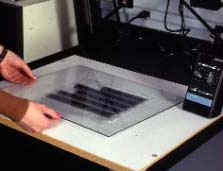Printing Angiograms
|
Janice Clifton, CRA COT |
Paul R. Montague, CRA FOPS |
Photographic Illustrations by |

After processing the film, the angiogram is a negative image, with the fluorescein dye appearing as a black image against a light background. Many ophthalmologists prefer to read angiograms which are positives, where the dye appears as a white image against a dark background. Even in practices where negatives are routinely used for interpretation, positive prints must occasionally be made for release to referring physicians or for use in publication.
Producing a positive angiogram requires photographic printing of the negatives. Photographic prints can be divided into two categories: Contact Prints and Enlargements.
Contact Prints are made by placing the negatives in direct contact with the print material producing a positive that is exactly the same size as the original negative. Contact sheets are useful for viewing the entire angiographic series as the negatives would be viewed. Contact sheets can be made on photographic paper or sheets of photographic film which can be viewed on an X-ray viewer.
Enlargements are made by placing the negatives in a vertical projector called an enlarger which is designed to project the negative onto photographic paper. The enlarger can be used to make prints of 16 x 20 inches in size or larger. Allowing for precise control of the amount and duration of light striking the paper, the enlarger is a perfect choice as a light source for making contact prints as well.
